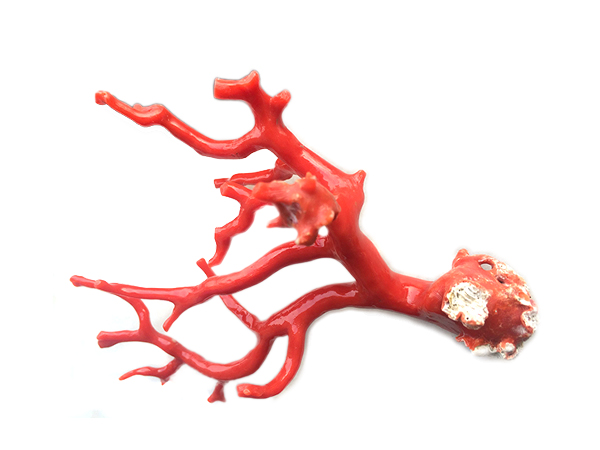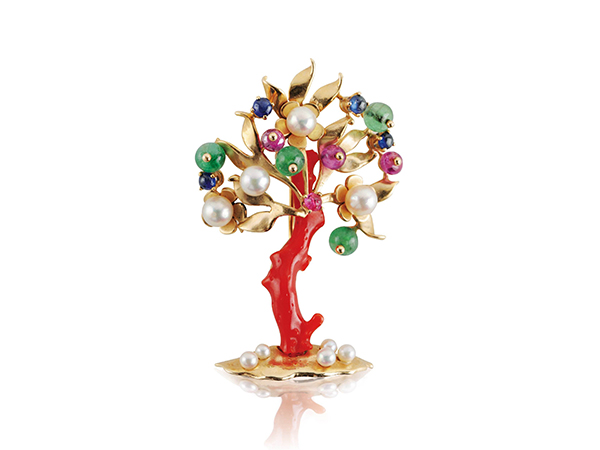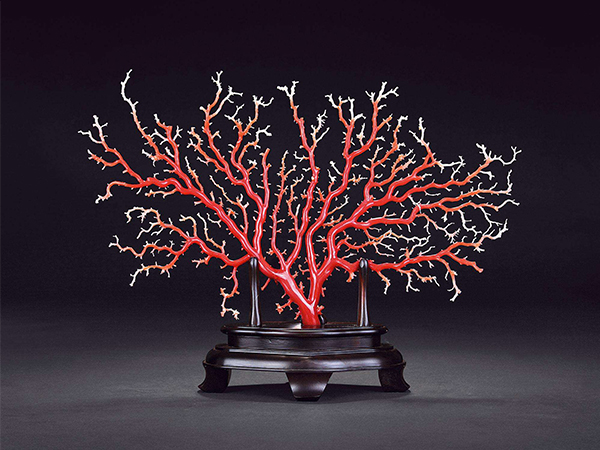CORAL

Natural red corals are formed by the accumulation of coral insects. They grow very slowly and are non-renewable. However, red corals only grow in a few straits (Taiwan Strait, Japan Strait, Baltic Strait, and Mediterranean Sea). Due to the restrictions of the sea area, red corals are extremely precious. Jewelry made of red coral is very popular with collectors, and the value of fine red corals is increasing very quickly, and it is valued by people in the collection industry.
Gem Quality
Coral's English name is Coral, from Latin. The ancient Romans believed that corals had the functions of preventing disasters, giving wisdom, stopping bleeding and driving heat.
The color of the red coral is pleasing and the texture is shiny. Red coral is an organic gem that grows in deep seas 100 to 2,000 meters away from humans. It is listed as three major organic gemstones with pearl and amber. It is also listed as one of the seven treasures in the Oriental Buddhist scriptures. It has been regarded as a rich and auspicious thing since ancient times.

In ancient China, red coral was regarded as the auspicious thing of happiness, representing noble power, so it is also called "Ruibao", a symbol of happiness and eternity.
Well-known coral connoisseurs said over the weekend: "Corals, the sea's elves." Indians believe that "precious corals are the mother of the earth." The emperor of Japan also regards red corals as its national essence. From the history of ancient and modern Chinese and foreign, red coral has a lofty status. The cap and the bead worn by the second-ranking official of the Qing Dynasty were made of precious red coral; Tibetan monks in Lama mostly held rosary made of red coral. At present, rare red corals are scarce and difficult to obtain, especially coral trees that are more than two feet tall are rare. At present, the importance of corals is gradually being recognized. Because of the rarity and non-renewability of corals, it is highly collectible. Natural red coral jewelry is more popular.
Substance composition
Red coral consists of two parts, inorganic and organic. Inorganic: high magnesium calcite, a small amount of apatite, calcium carbonate, magnesium carbonate, a small amount of water, ferrous oxide, calcium hydroxyphosphate. Organic matter: mainly horny.

Structure
Wave-shaped parallel fiber structure. Along the longitudinal direction of the coral branches, there are shades of color or different transparency to form a continuous wave-shaped parallel fiber structure. The cross section is concentric, like tree rings. There are many small round pits on the branches, which are the places where the coral burrows.
Coral species
Dead corals have completely stopped growing and are severely damaged.
The inverted coral has basically stopped growing, and the damage is still small.
Living corals, which can continue to grow on the sea floor, have thin films on the surface, and after polishing, are dazzling and exquisitely abnormal, making them the most valuable of red corals.
The colors of red coral are various, including dark red, ochre red, peach red, flesh red, pink, orange, milk yellow, milky white and so on. Industry Recognized Red Coral Color Range:
AKA (Aka), dark red, crimson, the highest value, mostly produced in Japan and Taiwan, China.
Sardines, bright red, common red on the market, mostly produced in Italy.
MOMO, Momo / Orange Red.

The price of red coral is more transparent, the heavier and more expensive, the sardine is 200-300 / g, and the average Momo is 250-500 / g. Arca is between 500-4000.
Evaluation basis
Color, luster, clarity, gloss.
Identification points
The preciousness of red coral has led to profit making by the fishermen. At the latest from the Republic of China, there was a "celluloid" of pure chemical products. The container was burned with coral glaze, wrapped with lead, and coated with a layer of coral paint. And painted textures, and carved into beads with ox bone or talc, Qin into red, are fakes and fakes sold as fake corals.
Some of these counterfeiting methods have been passed down to date, but it is not difficult to identify them: the "coral" made of materials contains air bubbles inside, and the broken part is shiny without real coral fingerprint-like patterns; the "coral" made of glass is Shell-shaped fractures, while the real coral notches are smooth; the "coral" made with the face has a shiny black hair, which has cracks over time, and the sound of the impact is dull; the "coral" dyed with bone keratin need only be wiped with acetone , It will distinguish between true and false.
Contemporary coral counterfeiting uses advanced science and technology, such as laser-washing with white coral or coral-like sea bamboo, and Gilson's "synthetic coral". It is very concealed. If you do n’t have rich experience or use scientific instruments, If it is detected, it will be easy for fisheyes to mix up.
First, look at the texture. Red corals have vertical stripes parallel to the direction of coral growth, and are arranged more closely. The cross section of the outer red coral has ring-like patterns like tree rings, and you should pay attention to these two textures when identifying with the naked eye.
Longitudinal view: The corals have parallel growth lines in the longitudinal direction, and the direction is parallel coral cylinders. If it is a ring face, it is usually on the back, if it is a carved piece, it is on the surface.
Horizontal: Coral cross-sections have growth rings like annual rings, ranging from small to large. Concentric circular growth patterns are usually seen on coral ornaments.

The color of corals is from the inside to the outside, for example: the closer a coral column is to the surface, the deeper the coral, the deeper the inner, and the lighter it is. In other words, the color of the corals is not uniform. If the color of the corals is consistent inside and outside, it is suspected that there is false.
Third, listen to the sound. The corals really look delicate but they have a crisp and clear sound when they collide with each other. Plastic or other imitation corals do not have this hard and crisp sound. This sound is particularly evident on branchy corals.
Fourth, the weight. Corals have a good sense of weight. Generally, placing them on the palm will give people a sense of heaviness that does not match their tenderness. This weight is also one of the basis for identifying red corals and some inferior counterfeits.
V. Identification of Natural Corals and Dyed Corals: Dyed corals usually use organic dyes to dye white corals into red and other colors. The distinguishing feature is that the dyes are enriched in cracks, and the external color is deep and the internal color is light. Use a cotton swab dipped in acetone to stain the cotton.
Differentiating a dyed coral depends on its degree of staining. For those who dye, the luster is not soft and natural, too glamorous, and there is no red in the red, but the real red coral is candle red, red has layers, and some are even red and white. The "fingerprint" is faintly displayed in the middle (the texture of calcium-containing corals Human fingerprints are similar), compared with dyed imitations.
1. White coral dyeing: commonly known as sea bamboo, which is characterized by a very obvious vertical texture.
2. Filled coral staining: It is made of shallow-sea reef-building corals with loose texture and filled with glue. Features: smooth surface, rough and fragile, easy to change color.
3. Synthetic coral dyeing: Various shellfish and gelatinized corals are ground into powder and molded into coral shapes without natural texture.
4. Various types of jade-like corals: dyed with dolomite and calcite. Features: If this dyeing is not handled properly, it will fade very quickly.
5. Plastic dyed coral: Red coral dyed with plastic products. Features: ① very light texture; ② easy to fade; ③ no natural texture, gloss.
6. Identification of natural corals and imitations: Common coral imitations include dyed marble, red glass, red plastic, and "Gilson coral" made with calcite powder and dye. These imitations do not have the internal structure of natural red coral, which can be discerned by careful inspection of the texture; the granulated structure of dyed marble, the dye is enriched in mineral particles, and the answer can be obtained by testing with acetone; the red glass type can do very well Similarly, bubbles are occasionally seen. From the point of view of hardness, glass is larger than coral and does not react with hydrochloric acid. The density of red plastic is generally less than 1.55, which is odorous when heated and does not react with hydrochloric acid. The density of Gilson coral is 2.45.
The main purpose
For jewelry and decoration.
Medicinal: it has the function of astonishing and obvious. As a medicine for epilepsy and keratitis.
Collection maintenance
First, please avoid heavy blows, collisions, so as to prevent the stones from falling off and being damaged;
2. Please avoid contact with chemicals, acids, alkaline liquids and perfumes;
3. Please wipe it with a soft cloth and keep it properly after each use;
Fourth, please always soak water, wipe oil, so that you can always keep "bright and bright";
5. Please wear coral jewelry often to make it harmonious with human spirituality;
6. Please prepare multiple pieces of coral jewellery according to the seasons to ensure the "beautiful as new" effect;
Seven, non-inlaid red coral necklaces, bracelets, pendants are worn next year is the best sacred product of blood circulation and health care.
Cultural significance
Red coral culture has a long history in China and the traditional cultures of India and Indian nations. Especially nomadic peoples such as Indian indigenous people and Chinese Tibetans are even more fond of red coral.
They even use red coral as a bodyguard and pray "God (Emperor) "Blessings. According to historical records, the use of red coral by humans dates back to ancient Roman times. The ancient Romans believed that corals had the function of preventing disasters, giving wisdom, and stopping bleeding and heat.
Some sailors believed that wearing red corals could prevent lightning and hurricanes, make the waves calm, and travel peacefully! As a result, the Romans called it "red gold", giving the red coral a mysterious color. Coral jewelry has been found in prehistoric tombs in ancient Egypt and Europe. Modern Westerners rank coral, pearl and amber as three major organic gemstones, and is one of the "March's Birthday Stones" in the West.
